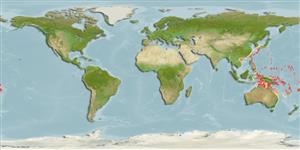>
Eupercaria/misc (Various families in series Eupercaria) >
Labridae (Wrasses) > Cheilininae
Etymology: Cirrhilabrus: Latin, cirrus = curl fringe + Greek, labros = furious (Ref. 45335).
Eponymy: Katherine A Meyer was the wife of John W Shepard of the Marine Laboratory at Guam. The etymology says: “This species is named katherinae in honour of Katherine A. Meyer, the late wife of John W. Shepard, at his request.” (Ref. 128868), visit book page.
More on author: Randall.
Environment: milieu / Zona climática / intervalo de profundidade / distribution range
Ecologia
marinhas associadas(os) a recifes; intervalo de profundidade 10 - 50 m (Ref. 37816). Tropical
Western Pacific: Miyake-jima, Izu Islands, Japan, Guam and the Mariana Islands.
Tamanho / Peso / Idade
Maturidade: Lm ? range ? - ? cm
Max length : 7.1 cm SL macho/indeterminado; (Ref. 5278)
Descrição suscinta
Chaves de identificação | Morfologia | Morfometria
Espinhos dorsais (total) : 11; Raios dorsais (total) : 9; Espinhos anais: 3; Raios anais : 9. Juveniles and females nearly uniformly orange-red. Males develop elongate pelvic fins and have brilliant blue bands on dorsal and anal fins.
Body shape (shape guide): fusiform / normal.
Known at depths ranging from 10 to at least 40 m at exposed outer reef areas than in lagoons or harbors. Occurs in aggregations. Maximum depth reported taken from Ref. 128797.
Ciclo de vida ou comportamento de acasalamento
Maturidade | Reprodução | Desova | Ovos | Fecundidade | Larvas
Distinct pairing during breeding (Ref. 205).
Randall, J.E., 1992. A review of the labrid fishes of the genus Cirrhilabrus from Japan, Taiwan and the Mariana Islands, with descriptions of two new species. Micronesica 25(1):99-121. (Ref. 5278)
Status na Lista Vermelha da UICN (Ref. 130435: Version 2025-1)
Ameaça para os humanos
Harmless
Uso pelos humanos
Ferramentas
Relatórios especiais
Baixar XML
Fontes da internet
Estimates based on models
Preferred temperature (Ref.
123201): 25.5 - 28.9, mean 27.7 °C (based on 124 cells).
Índice de diversidade filogenética (Ref.
82804): PD
50 = 0.5000 [Uniqueness, from 0.5 = low to 2.0 = high].
Bayesian length-weight: a=0.01585 (0.00700 - 0.03587), b=2.95 (2.76 - 3.14), in cm total length, based on LWR estimates for this (Sub)family-body shape (Ref.
93245).
Nível Trófico (Ref.
69278): 3.3 ±0.4 se; based on size and trophs of closest relatives
Resiliência (Ref.
120179): Elevada, tempo mínimo de duplicação da população menor que 15 meses (Preliminary K or Fecundity.).
Fishing Vulnerability (Ref.
59153): Low vulnerability (10 of 100).
🛈
Nutrients (Ref.
124155): Calcium = 142 [82, 299] mg/100g; Iron = 1.04 [0.58, 2.05] mg/100g; Protein = 18.1 [15.2, 20.4] %; Omega3 = 0.18 [0.10, 0.32] g/100g; Selenium = 22.1 [11.4, 45.5] μg/100g; VitaminA = 290 [86, 1,071] μg/100g; Zinc = 2.06 [1.32, 3.28] mg/100g (wet weight);
